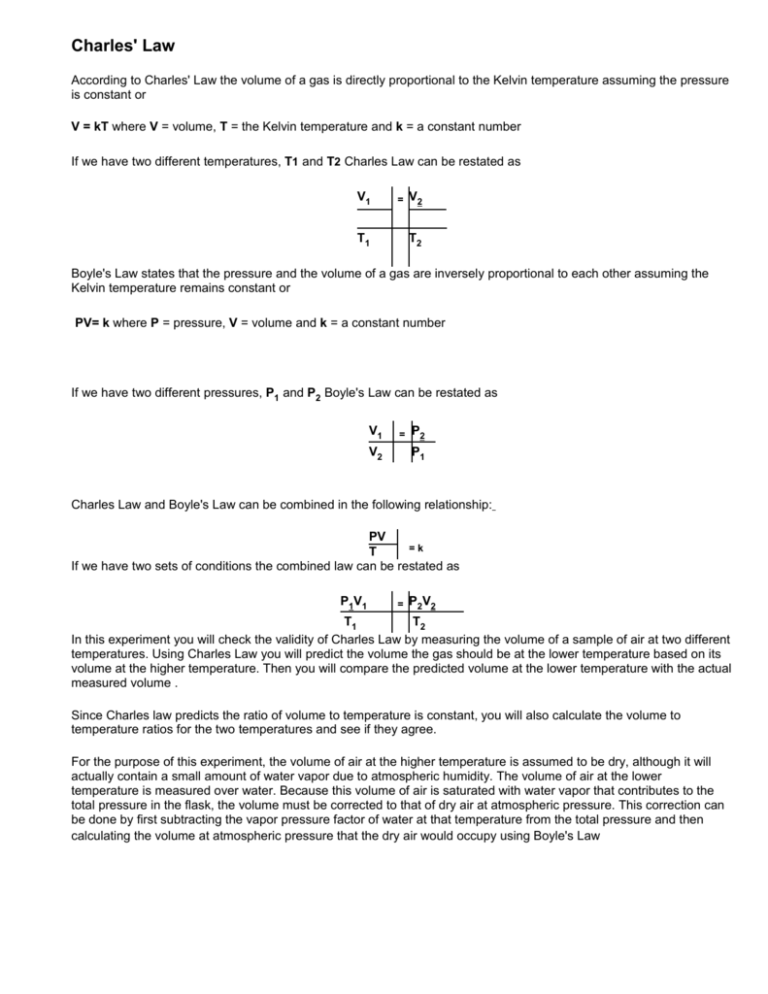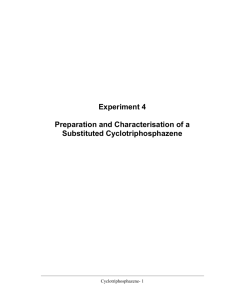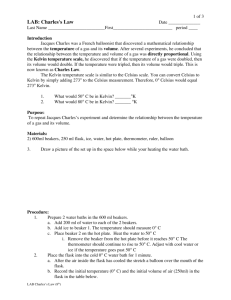Lab: Charles Law
advertisement

Charles' Law According to Charles' Law the volume of a gas is directly proportional to the Kelvin temperature assuming the pressure is constant or V = kT where V = volume, T = the Kelvin temperature and k = a constant number If we have two different temperatures, T1 and T2 Charles Law can be restated as V1 = T1 V2 T2 Boyle's Law states that the pressure and the volume of a gas are inversely proportional to each other assuming the Kelvin temperature remains constant or PV= k where P = pressure, V = volume and k = a constant number If we have two different pressures, P1 and P2 Boyle's Law can be restated as V1 = V2 P2 P1 Charles Law and Boyle's Law can be combined in the following relationship: PV =k T If we have two sets of conditions the combined law can be restated as P1V1 = P2V2 T1 T2 In this experiment you will check the validity of Charles Law by measuring the volume of a sample of air at two different temperatures. Using Charles Law you will predict the volume the gas should be at the lower temperature based on its volume at the higher temperature. Then you will compare the predicted volume at the lower temperature with the actual measured volume . Since Charles law predicts the ratio of volume to temperature is constant, you will also calculate the volume to temperature ratios for the two temperatures and see if they agree. For the purpose of this experiment, the volume of air at the higher temperature is assumed to be dry, although it will actually contain a small amount of water vapor due to atmospheric humidity. The volume of air at the lower temperature is measured over water. Because this volume of air is saturated with water vapor that contributes to the total pressure in the flask, the volume must be corrected to that of dry air at atmospheric pressure. This correction can be done by first subtracting the vapor pressure factor of water at that temperature from the total pressure and then calculating the volume at atmospheric pressure that the dry air would occupy using Boyle's Law Materials Erlenmeyer Flask, 250 cm3 Thermometer Beaker, 600 cm3 Graduated cylinder 100 cm3 Rubber stopper fitted with a pinch clamp Large dish pan Ring stand and clamp Hot plate Procedure Put a 600 cm3 about 2/3 full of water on the hot plate to boil. Meanwhile dry a 250 cm3 Erlenmeyer flask gently using a paper towel. If necessary put the flask briefly on the hot plate. Then allow the flask to cool. While it is cooling fit it with the rubber stopper and pinch clamp assembly. Insert the stopper into the flask and then gently immerse the flask into the boiling water as far as possible and clamp it in place with the clamp. Make sure that the rubber tubing coming out of the stopper is open See diagram below: Continue to heat the water until it is boiling. Keep the flask in the boiling water for at least 8 minutes to allow the air in the flask to attain the same temperature as the boiling water. Add water as necessary to maintain the level of water in the beaker. Read and record the temperature of the boiling water. While the flask is still in the boiling water pinch off the rubber tubing in the stopper using the pinch clamp and remove the flask from the boiling water and completely immerse it in a dish pan of cold water. With the flask completely submerged, open the pinch clamp under water, letting cold water flow into the flask. Keep the flask totally submerged for 4-6 minutes to allow the flask and its contents to attain the temperature of the water in the dish pan. Read and record the temperature of the water. In order to equalize the pressure of the air in the flask with that of the atmosphere, bring the water level in the flask to the same level as the water in the pan by raising or lowering the flask. See the diagram below. With the water levels equal, pinch the clamp to close the flask. Remove the flask from the water and set it on the lab bench. Using a graduated cylinder measure and record the volume of water that was drawn into the flask. Then fill the flask completely with water and measure the total volume of the flask by measuring the volume of water that it holds. Dry the flask and repeat the experiment again as time permits. Data Data Trial 1 Trial 2 1. Atmospheric Pressure. (record from Horizons computer or the barometer in room 216) 2. Temperature of cold water 3. Vapor Pressure of water for above Temperature 4. Temperature of boiling water 5. Volume of the flask 6. Volume of water absorbed by the flask Calculations 1. Calculate the pressure of the air at the lower temperature by subtracting the vapor pressure of water at the lower temperature from the atmospheric pressure. ( Line 1 - line 3) 2. Calculate the volume of wet air at the lower temperature by subtracting the water absorbed from the total volume of the flask. ( Line 5 - line 6) 3. Using Boyle's Law correct the volume of wet air to what it should be if it were dry Volume of dry air at low temperature = Volume of wet air x Pressure of dry air Atmospheric Pressure 4. Predict the expected volume at the lower temperature from the volume at the higher temperature using Charles' Law: Predicted Volume at low temperature = Volume at high temp X Lower temperature (in Kelvin) Higher Temperature (in Kelvin) 5. Calculate the percent error between calculation 3 and calculation 4 above, using calculation 4 as the true value. 6. Compare the volume / temperature ratios for the two temperatures. 7. On graph paper plot the temperature and volumes for high temperature and the low temperature, putting the temperature in Celsius on the x axis. Use values from -350°C to + 400 °C on your x axis. Draw a straight line between the two data points and extend it until it crosses the x axis. At what temperature does it cross? What is the significance of this point? Sample Calculations Charles Law Experiment Notes on Processing the data The following is a Sample Data Table. The data was made up for purposes of illustration. Sample Data *Atmospheric pressure Volume of the Flask Temperature of the boiling water Temperature of the cold water Volume of water absorbed by the flask Volume of air at the low temperature *Vapor Pressure of water at 21 degrees 765.0 torr 280 cm3 100.0 oC 21.0 oC 60.0 cm3 =280-60 =220 cm3 18.7 torr Pressure Units *Pressure in this example was measured in mm of mercury or torr. If your measured the pressure in inches of mercury multiply it by 25.4 mm per inch to get the pressure in torr. If you used millibars divide by 10.5 to convert your pressure to kilopascals (kPs). If you want to convert torr to kilopascals divide by 7.5. You may use either torr or kPa for pressure units in these calculations *The vapor pressure of water is available from Chemtables which I have loaded on the computer under the periodic table in room 217 or from your book. Calculations Step by Step 1. The air at the lower temperature is wet. Convert it to what the volume would be if it were dry. The process is as follows: • First subtract the vapor pressure of water from the atmospheric pressure 765.0 torr- 18.7 torr = 746.3 torr. • Multiply the volume at the lower temperature by a ratio of the pressure at the low temperature over the pressure at the high temperature 220 cm3 x (746.3 torr / 765 torr) = 214.7 cm3 2. Calculate what the predicted volume of the air would be at the low temperature based on Charles Law. The process is as follows: • Convert your temperatures to Kelvin 100oC + 273 = 373 K 21oC + 273 = 294 K • Multiply the volume of the flask by a ratio of the low temperature divided by the high temperature 280 cm3 X (294K / 373K ) = 220.7 cm3 3. Compare the two values: 220.7 cm3– 214.7 cm3 = 6.0 cm3 Percent error = (6.0 cm3/220.7 cm3) x 100 = 2.7% 4. Plot a graph with temperatures on the x axis and volume on the y axis. Extrapolate the line to find the x intercept. This value should correspond to absolute zero. In the sample data above you would use T1 = 100 oC, V1 = 280 cm3 T2 = 21 oC V2 = 214.7 cm3






